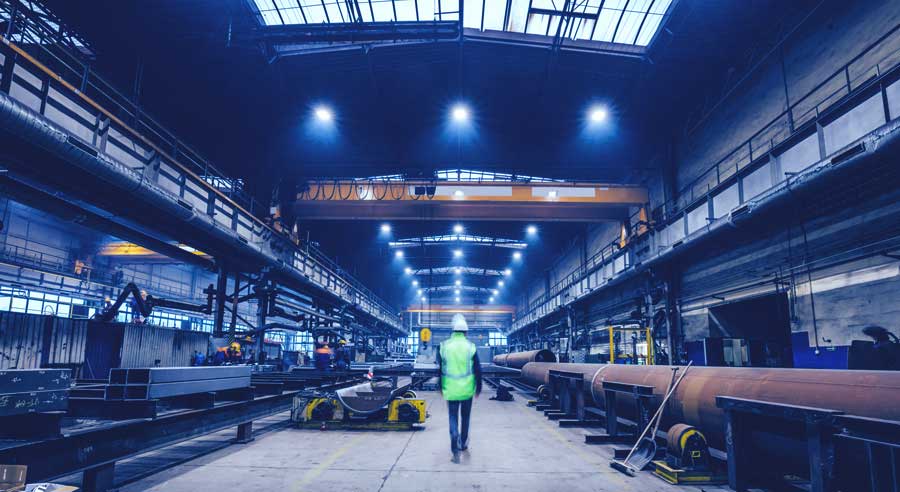HEATING FOR HALLS: CHALLENGES AND SOLUTIONS
Room volume, employee needs, climate protection goals, heating costs, and, and, and: When choosing the right heating system for your halls, you need to consider a whole range of factors. Read this article to find out what these are in detail and how you can master these challenges with a modern system.
First challenge in heating for halls: The structural characteristics
The biggest challenge in terms of heating for halls is probably the enormous spatial volume of hall buildings and their ceiling heights of four, ten or more meters. Keeping these buildings at a constant working temperature in winter is anything but trivial. Especially if the energy costs are not to get out of hand.
Added to this is the difficulty that no two industrial or commercial buildings are the same. High racks, overhead cranes, a wide variety of floor plans and usage profiles all place their own demands on the heating system to be installed. Simply distributing a few heaters in the room is not enough here. Due to their size and height, hall buildings have very special requirements in terms of building physics, which differ fundamentally from multi-story buildings. Therefore, it is worthwhile to consult a designated hall heating expert in order not to have to live with compromises in terms of functionality and end up investing a lot of money unnecessarily for insufficient performance.
Not always in view, but a relevant factor in heating for halls: Employee needs and a productive indoor climate
The structural characteristics of hall buildings also make it difficult to influence the indoor climate as desired and thus ensure a good working atmosphere. However, this is an important factor for the productivity of your employees: Ideally, the temperature in the work area should be 18 to 20 °C. But not every employee needs the same temperature. But not every employee needs the same temperatures: those who do physical work would naturally like it cooler than their colleague with a quiet activity while sitting or standing. When it comes to choosing the right heating system for your halls, this poses another challenge, because it means you have to plan for different zones that can be heated flexibly. Both in terms of working areas and in terms of usable zones.
Different hall zones require flexible systems
Let's take a closer look at what everyday life in industrial and commercial halls looks like: In one area of the hall, temperature- and condensation-sensitive goods are stored that must be kept at a uniform temperature. At the other end, a door remains open despite the freezing outside temperature - why close it if it has to be opened again? There is no need to run the heating here. It would be a waste of energy and money. In between, there are the workplaces already mentioned with different temperature requirements.
In addition, there are ceiling cranes that are parked under the heater from time to time and block the heat radiation. Perhaps the heater is also switched off overnight to keep operating costs down - and has to heat up again the next morning just in time for the start of operations. Without long lead times, of course. In view of all these points, it makes little sense to rely on heating systems for halls that continuously heat the air. Flexible systems are needed!
Energy and climate policy comes more into focus
With regard to heating systems for halls, however, it is no longer just what happens inside the hall that counts. What happens outside the building is also becoming increasingly relevant. We are talking here about climate protection and thus energy consumption. By 2030, primary energy consumption in Germany is to be reduced by 30% compared with 2008, and halved by 2050 - that's what the Energy Efficiency Strategy 2050 of the German Federal Ministry for Economic Affairs and Energy says. In the building sector in particular, the Federal Republic wants to drive energy efficiency forward in the process.
For hall owners planning a new heating system, this means the next challenge: It is essential to rely on heating systems that are as efficient as possible and fuels with low emissions in order to reduce energy consumption to a minimum. Ideally, residual heat is also used to really get the most out of heating your halls. Using energy optimally in this way protects the environment and is in line with climate protection targets. Because one thing is clear: less fuel consumption - less emissions. But you should also rely on energy-saving hall heating systems in your own interest. Because:
The question of the right heating system for your halls is closely related to the question of costs
Over their life cycle, hall heating systems consume six to twenty times more energy than the investment costs. This makes the operation of these heating systems significant cost drivers for hall owners, which are difficult to get under control without an efficient, flexible system. Let's take a look back at the aspects that arise from the specifics of the building and the day-to-day work.
Heating the entire room volume: Unnecessary energy consumption. Air heated by hot-air heating systems that accumulates under the ceiling of the hall: unnecessary energy consumption. Heating unused hall zones: Unnecessary energy consumption. Overheated hall areas because heating cannot be flexibly controlled: Unnecessary energy consumption. Heaters that continue to heat even when the hall doors are open: Unnecessary energy consumption. Heaters that have only been heating the overhead crane parked underneath them for hours: Unnecessary energy consumption. Overall, heating that does not match the usage profile of the hall - unnecessary energy consumption.
The list could be continued endlessly, but it has certainly already become clear: Only modern, intelligently operating heating systems that have been specifically developed as heating systems for halls will help you avoid precisely such energy-wasting traps and thus keep both investment and running costs low. And this also with a view to the future. Because heating costs will continue to rise in the coming years. The reason for this is the CO2 tax on the use of fossil fuels, which has been in force in some countries such as Germany since January 1, 2021. It therefore makes sense, on the one hand, to rely on a particularly low-CO2 fuel such as gas and, on the other hand, on a highly efficient heating system for your halls - unless you want to put up with the rising costs.
This makes it clear: There are a whole range of challenges when it comes to selecting heating systems for halls. It's good if you know them and can avoid them in a targeted manner. Thus, in conclusion, the question arises:
What is the solution to these challenges?
As described at the beginning, no two halls are alike. The selection of the right heating system for your halls must therefore also take into account your individual circumstances. There is no blanket solution. In principle, however, you can meet all the challenges mentioned above with a modern, gas-powered infrared radiator system from a ceiling height of four meters. With the help of intelligent control technology and modular extensions, problems such as open hall doors can be detected and the heating in this area can be switched off.
On a zone-by-zone basis, the heater can meet different temperature requirements. Since infrared heaters do not heat the air per se, there is no dust turbulence or unpleasant drafts. Also, no warm air accumulates unused under the hall ceiling. Simply put, such a heating system heats only what is really necessary. In combination with natural gas as a fuel (which has a high primary energy factor and is becoming increasingly green) and intelligent use of residual heat (for example, to heat adjacent offices), you kill all birds with one stone: manageable investment costs. High energy efficiency. Satisfied employees. Low total cost of ownership. Environmental protection. So when choosing a heating system for your halls, go for the right solution right from the start!




